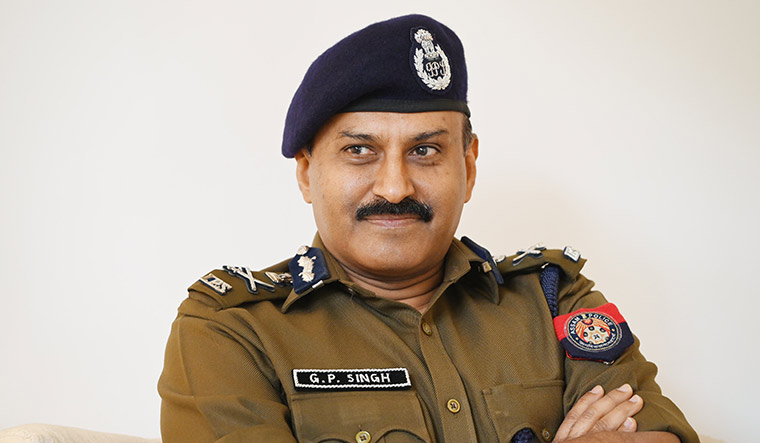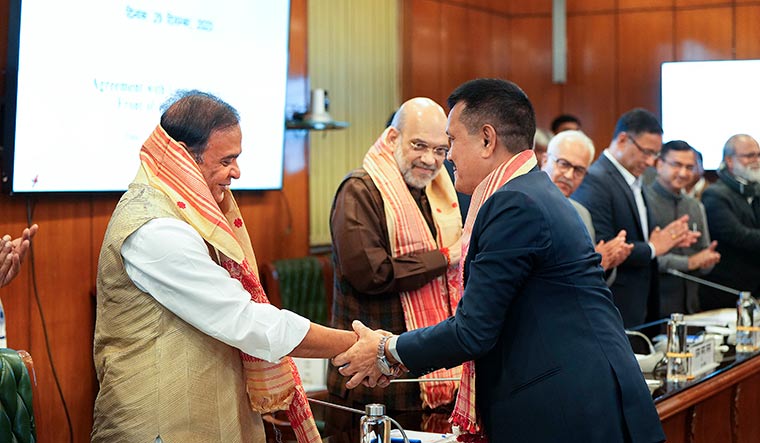Draping the traditional red and white Assamese gamcha around his neck, Chief Minister Himanta Biswa Sarma looked content as he stepped out of the North Block on the evening of December 29. The conference room in the British-era building, where he sat with United Liberation Front of Asom (ULFA) chairman Arabinda Rajkhowa and general secretary Anup Chetia, has witnessed the resolution of many demands for sovereignty left unresolved by the British, especially in the northeast. After the meeting, Sarma, Chetia and Rajkhowa agreed to a solution to the rebellion waged by ULFA since 1979, marking the beginning of the end of one of the longest-running insurgencies since independence.
As Union Home Minister Amit Shah joined the trio to sign the tripartite agreement, it was a symbolic ‘Ek Bharat, Shreshtha Bharat’ moment. For Sarma, it was also a triumph of his love for the Brahmaputra valley, which was very much at display when they all exchanged gamchas, an article of significance worn by the indigenous people of Assam. It cemented Sarma’s position as the tallest leader from Assam.
The northeast is geographically cut off from the rest of the country, but for the narrow Siliguri Corridor, known as the Chicken’s Neck. This region shares borders with Bhutan, Bangladesh, Nepal and China, and has historically been the playground for armed insurgent groups like ULFA. Lives of the people in the northeast have been split between cries for sovereignty by armed insurgent groups and their own desire to participate in the growth story of the rest of the country.
The peace accord with ULFA is the ninth settlement with insurgent groups during the tenure of the Modi government. It is significant as it breaks the 44-year-long uncertainty in the lives of the common man. Sarma’s interest in internal security and his assessments have been unmatched. In 2021, when he took charge as chief minister, he tweaked the internal security approach. He ordered tough police action against armed insurgents, prevented ULFA cadres from carrying out extortion, facilitated mass surrenders of key militants and doled out rehabilitation packages that proved an attractive proposition.
“Protracted dialogue between the government and the pro-talks ULFA faction witnessed several ups and downs, but the chief minister’s political acumen and understanding of ground [realities] helped clinch the final peace settlement,” said G.P. Singh, director-general of police, Assam. The clincher was the decision to conduct a delimitation exercise last year, which won the support of the ultras. The delimitation safeguards the rights of the indigenous people by making it near impossible for non-indigenous communities to contest in assembly elections.
 G.P. Singh | Salil Bera
G.P. Singh | Salil Bera
The 12-point tripartite agreement includes the promise to recommend to the Election Commission to follow the broad guidelines and methodology adopted for the delimitation exercise in future delimitations as well, the offer to create an error-free National Register of Citizens (on the basis of the decision by the Supreme Court), maintaining Assam’s territorial integrity, preventing illegal migration, taking measures to prevent the enrolment of illegal migrants in the voters lists and supporting exemption for Assam from the section 3 of the Citizenship Act 1955.
“ULFA is disbanding,” said Singh, “dismantling various camps inhabited by around 750 cadres. It will also share the list of members who are eligible for jobs.” He said the militants outside the country were also being persuaded to return to Assam and work with the government. “We recognise their love for the state of Assam,” he said. But he also issued a warning against those who planned to indulge in violence again.
Sarma made the accord possible by keeping a line of communication open with ULFA (Independent) chairman Paresh Baruah, who continues the armed struggle even after Rajkhowa was caught in Dhaka and was sent to India. Sarma is in regular touch with Baruah, who lives in China. But there are only around 200 cadres left with his group. While some of them are in camps on the India-Myanmar border, a few others like Drishti Rajkhowa, Baruah’s close confidant, got a safe passage to Assam in 2019, a rare case when he permitted the surrender of an insider. “The chief (Baruah) inquires about my life in Assam. I told him things have changed for the better and people no longer demand sovereignty. Today, they are very much part of the economic and sociocultural development of the state,” said Drishti.
Also Read
- Exclusive: 'Modi has overtaken Nehru', says Assam CM Himanta Biswa Sarma
- How Himanta Biswa Sarma has emerged as key architect of BJP's vision for northeast
- 'We disbanded for the people of Assam': ULFA chairman Arabinda Rajkhowa
- 'Paresh Baruah told me he is interested in talks': ULFA general secretary Anup Chetia
- ‘In India you can be pro-Christian, pro-Muslim, but you can’t be anti-Hindu’: Himanta Biswa Sarma
Baruah is a hardliner and surrender would be his last option, but the government has made it clear that talks can happen only within the ambit of the Indian Constitution. The geopolitical situation still remains vulnerable, with the possibility of covert support from cross-border state and non-state actors, especially within China, and attempts to use Indian insurgent groups as mercenaries by inimical forces in Myanmar. On the other hand, friendly governments in Bhutan and Bangladesh are proving helpful by not allowing safe havens to fleeing militants.
The next big challenge for Sarma would be to help stitch together the remaining peace agreements in the northeast, like the elusive Naga peace accord. When Naga political leaders who are in talks with the government rang up to congratulate Rajkhowa, he told them, “We have been guerrilla fighters living in jungles and running from one country to another. But time has come to honour the will of the people who want peace and progress.”


